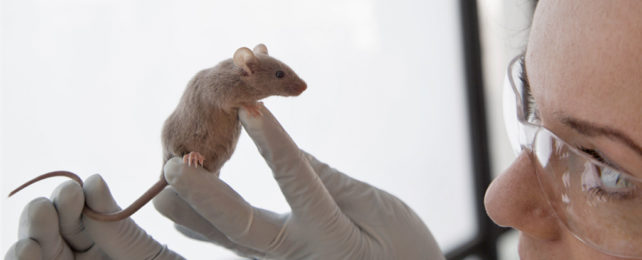University of Maryland psychiatrist Polymnia Georgiou and colleagues accidentally came across an unexpected example of researchers unwittingly skewing a study's results when their laboratory mice's reactions to ketamine differed depending on the sex of the humans who administered the drug.
To check it wasn't just a weird fluke, they did a blinded, randomized trial with an even mix of male and female experimenters. The mice indeed had a greater antidepressant response to ketamine when handled by male humans.
Obviously, the presence of male humans does not somehow change the properties of ketamine, so the researchers probed deeper to confirm the exact mechanism.
Oddly, another type of antidepressant, desipramine, worked just fine when administered by both male and female experimenters.
Stressing the mice by other means also didn't help the mice respond to the ketamine when administered by female researchers. This led Georgiou and colleagues to conclude the sex effect was very specific to how ketamine works inside the mice.
A series of stress tests revealed that the presence of not just human male experimenters but also their clothing caused the mice to display more signs of anxiety, pain, and depression: Based on one trial, both female and male mice preferred to be near T-Shirts that had been worn by female humans rather than those from males.
A 2014 study also found lab rodents become stressed in the presence of male researchers. In this case, the presence of male experimenters seemed to inhibit their pain response through a stress-induced analgesic effect.
Previous research testing human male scent on mice identified brain activity in an area with known links to depression, leading (after some trial and error) Georgiou and the team to investigate the neurons that release corticotropin-releasing factor (CRF).
So they gave the female experimenters the hormone CRF to administer with the ketamine, and sure enough, the mice responded to the antidepressants the same way they did when males gave ketamine to them.
All this amounts to ketamine working better when administered by males because their scent stresses the mice, activating the CRF system, which enhances their body's stress response.
"Compared to humans, mouse sense of smell and their sensitivity to pheromones (airborne hormones) are more keenly developed, so it's not surprising that they respond differently to many smells, including those of men compared to women," says University of Maryland psychiatrist Todd Gould.
The findings also confirm ketamine works with the CRF pathway.
"Our findings in mice suggest that activating a specific stress circuit in the brain may be a way to improve ketamine treatment," explains Gould.
These results may also be the missing piece of the puzzle as to why some people respond well to ketamine as an antidepressant while it frustratingly doesn't seem to help others at all.
"Our thought is that you may be able to provide a more robust antidepressant effect if you combine the ketamine with activation of this brain region, either a drug that spurs this process in the brain or even some sort of specific stressor," says Gould.
This, of course, would have to be further tested in humans to be confirmed, as many animal model studies do not translate well to humans. The observer effect demonstrated here may also contribute to this translation problem as well.
"The problem is easily solved by simple changes to experimental procedures. For example, since the effect of males' presence diminishes over time, the male experimenter can stay in the room with the animals before starting testing," McGill University psychologist Jeffrey Mogil recommended in 2014. "At the very least, published papers should state the gender of the experimenter who performed the behavioral testing."
Experimenter's sex is far from likely to be the only factor researchers are neglecting to take into account that skew results, Georgiou and team warn, citing a long list of other possibilities from cage conditions, overall stresses, circadian cycle, diets of experimenters, and more.
Investigating these factors could help increase the robustness of all biological research by allowing for greater replication of experiments and also provide heaps more insights into our shared biology, the researchers conclude.
This research was published in Nature Neuroscience.
